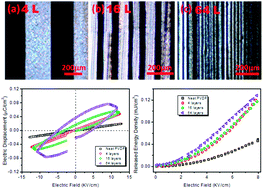Dielectric hysteresis behaviors of polyvinylidene fluoride-based multilayer dielectrics controlled by confined distribution of conductive particles†
Abstract
Polyvinylidene fluoride (PVDF)-based multilayer dielectrics containing alternating layers of carbon black (CB) were fabricated through layer-multiplying extrusion. Benefits from the presence of PVDF between CB-containing layers, the breakdown strength and hysteresis behaviors of the multilayer specimens were investigated. The multilayered distribution of conductive particles was considered to be preferred for controlling the energy conversion and storage of dielectric materials.


 Please wait while we load your content...
Please wait while we load your content...